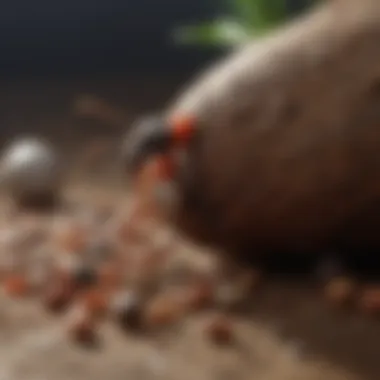Top Ant Traps: Your Complete Buying Guide


Intro
Dealing with ants in the home can be a frustrating experience. While these creatures are an important part of the ecosystem, their presence in your living space can lead to contamination of food and damage to property. Understanding how to effectively manage these pests begins with identifying them and recognizing the signs of infestation. This guide aims to walk homeowners through the intricacies of ant traps, offering insights on their effectiveness, ingredients used, and practical application.
Pest Identification
Identifying the specific species of ants invading your home is crucial in determining the most effective control methods. Common household ants include:
- Carpenter Ants: These larger ants can cause structural damage by nesting in wood.
- Sugar Ants: Attracted to sweets, they often invade kitchens.
- Pavement Ants: Found outdoors, they venture inside seeking food.
Common Household Pests
Each type of ant has unique behaviors and characteristics. Recognizing these can help homeowners act swiftly. Carpenter ants, for example, often leave sawdust-like debris, while sugar ants leave trails towards food sources.
Signs of Infestation
Indications of an ant infestation can vary. Pay attention to:
- Visible trails: This indicates a path to food.
- Nesting materials: Look for small piles of dirt or debris.
- Sightings: Frequent sightings of ants can signal a larger problem.
Identifying the correct species of ant is essential for effective pest management. Species-specific solutions can offer a higher success rate.
Prevention Methods
Preventing an ant infestation is a more effective strategy than dealing with one after it has occurred. Small changes in your environment can make a significant difference.
Environmental Modifications
To deter ants, homeowners should
- Seal entry points such as cracks in doors or windows.
- Maintain clear gutters to prevent water accumulation.
- Ensure that food is stored in airtight containers, minimizing the availability of tempting morsels.
Home Maintenance Tips
Regular home maintenance can thwart ant activity. Regularly inspect areas prone to moisture and food, such as kitchens and under sinks. Moreover, keeping the yard tidy by eliminating debris and overhanging branches can also help.
DIY Pest Control Solutions
Many homeowners prefer natural remedies for pest control. Simple household ingredients can be as effective as commercial products.
Natural Remedies
Several natural options exist to repel ants. Some of these include:
- Vinegar: A mixture of equal parts water and vinegar can disrupt ant trails.
- Essential oils: Peppermint oil can act as a deterrent.
- Boric Acid: Used cautiously, it can be a powerful tool against ants.
DIY Traps and Barriers
Creating your own traps can be both cost-effective and simple. A popular DIY ant trap includes:
- Mixing boric acid, sugar, and water in a container.
- Soaking cotton balls in this mixture and placing them near the ant trails.
- Monitoring the traps regularly to replace as needed.
Understanding Ant Behavior and Control
Understanding the behavior of ants plays a crucial role in effective pest control. Ants are social insects that operate within complex colonies. Each colony has a structure with roles assigned to different ants, including workers, soldiers, and reproductive members. By recognizing these behaviors, homeowners can target infestations more successfully.
Ants communicate and navigate using pheromones. They leave scent trails for others to follow, making it essential to disrupt these trails during control efforts. This knowledge allows for targeted treatment strategies, maximizing the effectiveness of traps.
In this article, we will discuss two key elements that further aid in ant control: species identification and recognizing common infestations. Knowing which species infest your home helps in selecting the right traps and treatment methods. The insights into common infestations can help households detect early signs, leading to timely interventions that can prevent larger problems.
Ant Species Identification


Identifying ant species is vital for effective pest management. Different species exhibit varying behaviors and nest preferences. For example, Carpenter ants prefer moist wood, whereas Odorous house ants are more likely to invade homes for food sources.
- Carpenter Ants: Known for nesting in wood, these ants can cause structural damage. They are generally larger and black or bicolored in appearance.
- Odorous House Ants: Small and dark, these ants emit a distinctive smell when crushed. They are often found in large colonies inside homes, especially around food.
- Fire Ants: Recognized by their painful sting, they create large mounds outside and can enter homes in search of food.
- Pavement Ants: Found beneath pavement slabs, these ants are smaller and brown or black. They can invade homes particularly during warmer months.
Identifying these species can guide users towards the most effective traps suited for their specific infestation.
Common Ant Infestations
Common ant infestations vary based on regions and seasons. Recognizing these patterns is crucial for effective control strategies.
- Kitchens: Many ants invade kitchens in search of food. Common species include Odorous house ants and Carpenter ants. They are drawn to crumbs and spills.
- Bathrooms: Ants seeking moisture often target bathrooms. This is particularly the case for species like Pharaoh ants, which thrive in humid areas.
- Gardens and Yards: Outdoor infestations usually include Fire ants and Pavement ants. They can build nests in gardens, posing a risk when they invade homes seeking food or establishing new colonies.
Understanding the patterns of ant infestations allows homeowners to take proactive measures to prevent and control these pests.
In summary, recognizing the types of ants and their typical behavior helps in the selection of appropriate control methods and traps. It lays the groundwork for efficient management of ant infestations.
Types of Ant Traps
Understanding the different types of ant traps is crucial for effectively managing ant infestations. Each type serves specific purposes and operates under unique principles, tailored to various situations. Selecting the right trap can influence how quickly and effectively you can deal with an ant problem. Here is a closer look at the common types of ant traps available.
Baited Ant Traps
Baited ant traps are among the most popular solutions for ant control. These traps contain a lure, often made of food or sugar-based substances, designed to attract ants. Once the ants consume the bait, they carry it back to their nest, where it can affect the entire colony. This method is particularly effective for dealing with larger infestations as it directly targets the source of the problem.
When choosing baited traps, consider the bait's active ingredients. Not all baits are equally effective, and some may take longer than others to show results. Most baited traps are easy to set up and can be placed in areas where ants are commonly seen. It is important to avoid disturbing the traps to allow ants to find and use them.
Sticky Traps
Sticky traps are another useful option for ant control. These lightweight traps are coated with a sticky adhesive that catches ants when they walk across the surface. Sticky traps can capture various insects, but they are particularly helpful for monitoring ant activity in your home.
The charm of sticky traps lies in their simplicity. You can place them in areas where you suspect ant activity. However, sticky traps do not eliminate the ant problem; instead, they help you identify how severe the infestation is and which types of ants are present. While they can help monitor the ant population, they may not provide a long-term solution to the infestation.
Gel Baits
Gel baits offer a different approach to ant control by combining the benefits of baited traps and convenience. These gels often contain similar attractants as baited traps but in a more flexible application. You can apply them in gaps or cracks where ants are entering your home.
Gel baits are advantageous because they remain effective for an extended period, even after application. They are moisture-resistant and can stay in place, allowing ants to feed on them steadily. This type of bait may require some patience, as it can take several days for the gel to eliminate the colony. However, if used correctly, gel baits are quite effective.
Insecticide Sprays and Powders
Insecticide sprays and powders represent a more aggressive form of ant control. These products typically contain chemical compounds designed to kill insects on contact. While insecticides may provide quick results, they can pose risks to pets and children if not used carefully.
When using these products, it's crucial to follow the manufacturer's instructions. Make sure to identify the type of ant you are dealing with, as some sprays work better for specific ant species. Additionally, using insecticides might not address the entire problem if the colony remains intact. In concluding, while they are effective for immediate control, insecticides should be part of a broader strategy that includes monitoring and prevention methods.
Factors to Consider When Buying Ant Traps
When it comes to selecting an ant trap, several factors warrant consideration. Each plays a role in ensuring you choose a product that aligns with your needs and specific situation. Making an informed choice not only enhances the efficacy of your pest control efforts but also safeguards your household and environment. Here are some key elements to consider:
Efficacy of the Trap
The effectiveness of ant traps is paramount. Traps must effectively lure and eliminate ants while ensuring that they don't simply provide a temporary solution. Different traps utilize diverse methods, such as attractants or poison, to control ant populations. Look for products that utilize active ingredients proven to work against the specific ant species infesting your area. It is equally important to read user reviews or seek professional recommendations. The right trap should not only kill ants but also disrupt their foraging behavior to prevent future infestations.
Safety for Pets and Children
Safety should not be compromised when choosing an ant trap. Many homeowners share their living spaces with pets and children, making it critical that any pest control solution used is non-toxic and safe. Opt for traps designed with specific safety features. For example, some traps have tamper-proof designs to keep curious pets and children from accessing the bait. Check labels for safety certifications or natural ingredient lists. Products that are deemed safe for use near food and living areas are generally preferable.
Environmental Impact
Choosing environmentally friendly ant traps is becoming increasingly essential. Many conventional traps may contain harmful chemicals that pose risks to the environment. These substances can leach into soil or water systems, affecting local flora and fauna. Look for traps that employ biodegradable materials or natural ingredients. Some brands highlight their commitment to eco-friendly practices, which is an added advantage. Research can reveal which products align with your environmentally conscious values.
Cost and Value for Money
Cost considerations play a significant role in the decision-making process. While some traps may have a lower price point, assessing their long-term value is crucial. A less expensive trap may require frequent replacement or may not effectively resolve the ant problem, leading to more investment over time. Conversely, a slightly pricier trap that effectively eliminates the issue might save money in the long run. Evaluate the number of traps per package, the efficacy, and whether the trap offers features that justify its cost. Evaluating these elements will help you determine the best value for your situation.


Top Ant Traps Reviewed
Understanding the Importance of Reviewing Ant Traps
In the fight against ant infestations, the selection of an effective trap plays a significant role. This section analyzes various ant traps available on the market, focusing on their functionality, user satisfaction, and overall effectiveness. Understanding which traps work well can lead to better pest management in homes.
Researchers and homeowners often look for traps that not only attract ants but also ensure complete extermination of the colony. Evaluating the effectiveness of different traps helps buyers make informed decisions, allowing them to choose products that are reliable and efficient.
This Trap's Effectiveness
The effectiveness of an ant trap is determined by several factors, including its ingredients, design, and the specific ants it targets. For instance, bait traps lure ants and often contain substances that attract them, such as sugar or protein. Once the ant consumes the bait, it takes some back to the nest, effectively killing the colony. This process can take a few days, but it is a crucial feature for long-term control.
Some of the top-rated traps are designed to minimize harm to the environment and are safe for household use. Many modern traps use less toxic ingredients, which can be particularly appealing to those with pets or children around. Reviews from users provide insights into how well these traps perform and if they meet expectations.
Pros and Cons
When considering different ant traps, it’s essential to weigh their pros and cons. The following points summarize some advantages and disadvantages commonly noted in user reviews:
Pros:
- High Effectiveness: Many traps are designed to kill multiple types of ants, ensuring a broad approach to pest control.
- Ease of Use: Most traps are straightforward to set up and require little ongoing maintenance.
- Increased Safety: Many current traps are safe for environments with children and pets.
- Cost-Effective Solutions: Various traps are available at reasonable prices, providing good value for the effectiveness they offer.
Cons:
- Time Delay in Results: Some users report that it can take longer than expected to see reductions in ant activity.
- Specificity of Baits: Not all traps work equally well for every ant species, which can lead to mismatched expectations.
- Limited Coverage: Some traps are designed for indoor use only and may not be effective outdoors.
"Choosing the right trap involves understanding your specific infestation type and the features of the traps available."
By carefully weighing the effectiveness and drawbacks of various ant traps, a homeowner can make a knowledgeable and confident decision. This informed approach is essential in effectively managing household pests.
DIY Ant Trap Solutions
Creating your own ant traps can be an effective and economical way to manage an ant problem. This section delves into the significance of DIY ant trap solutions within our comprehensive guide. The advantages of homemade traps extend beyond cost savings; they can also be tailored to meet specific needs and preferences.
Additionally, DIY traps often utilize common household ingredients that are safe for kids and pets, addressing safety concerns that many commercial options may overlook. With a wide array of potential ingredients available, individuals can select those that suit their tastes and preferences, making this method quite flexible.
Homemade Baits
Homemade baits are among the simplest and most effective solutions for controlling ants. To create an effective bait, you typically need a sugar source and a protein source. Here’s a basic recipe:
- Ingredients:
- Instructions:
- 1/2 cup of sugar
- 1/8 cup of water
- 1 tablespoon of boric acid or active yeast
- Mix the sugar with water until it dissolves.
- Add boric acid or active yeast to the mixture.
- Soak cotton balls in the solution and place them where you observe ant activity.
This recipe combines the appeal of sweet substances to lure ants, while the boric acid serves as a slow-acting insecticide.
Monitoring your bait's effectiveness is crucial. You should note the number of ants that interact with the bait. If the number is decreasing over time, your trap works. Adjusting the placement and quantities may enhance the outcome.
Using Household Items
Leveraging household items for ant traps is not only convenient but also highly resourceful. Here are some widely available items that can help:
- Vinegar: A common household anti-ant solution. Mixture of equal parts vinegar and water can be sprayed in areas where ants frequently appear. Although it will not kill ants, it disrupts their scent trails.
- Soap and Water Solution: Combining soap with water not only eliminates ants on contact but also can block entry points when applied to surfaces.
- Peppermint Oil: This essential oil serves as a natural insect repellent, making it a great option. Mixing a few drops of peppermint oil with water and spraying around your home can deter ants.
In summary, methods of using household items are accessible and require little preparation time. Most importantly, they minimize reliance on chemical solutions, appealing to health-conscious consumers. By adopting these strategies, homeowners can explore creative solutions for managing ant infestations.
Where to Buy Ant Traps
Finding the right ant traps is crucial for effectively managing pest issues in your home. This section explores various purchasing avenues, highlighting the benefits and key considerations for each option. Knowing where to buy your ant traps can significantly influence your choice and the outcome of your pest control efforts.
Online Retailers


Online shopping has transformed how consumers access products, including ant traps. Numerous websites offer a wide range of options, making it easy to compare brands, prices, and reviews. Websites like Amazon, eBay, and specialized pest control sites allow for convenient purchasing from the comfort of your home. The benefits of buying from online retailers include:
- Extensive Selection: Shoppers can find a variety of ant trap types and brands in one place.
- User Reviews: Online platforms often feature customer feedback, providing insights on product effectiveness.
- Competitive Pricing: Online retailers frequently offer promotions and discounts, making them affordable options.
However, consider the potential drawback of waiting for shipping and verifying the credibility of the seller.
Local Hardware Stores
Local hardware stores can also be a great source for ant traps. Visiting these establishments not only allows you to view the products firsthand but also offers the opportunity to ask store employees for advice. Some advantages include:
- Immediate Access: Products are available for purchase and use without any waiting period.
- Personal Assistance: Staff often have knowledge about pest control products and can help you choose the right trap based on your specific needs.
- Supporting Local Business: Purchasing locally contributes to your community's economy.
However, the selection may be limited compared to online options.
Big Box Retailers
Big box retailers, such as Walmart and Home Depot, provide a middle ground between local hardware stores and online shopping. They typically offer a range of ant traps along with other pest control items, making them a convenient option. Some pros are:
- Wide Variety: These stores often carry multiple brands and types of traps at competitive prices.
- One-Stop Shopping: Shoppers can purchase ant traps along with other household necessities in a single trip.
- In-store Promotions: Large retailers often have deals that can save you money on bulk purchases.
It's essential to check the stock before heading out, as availability can vary by location.
When purchasing ant traps, consider your specific situation, such as the infestation size and the areas affected. This will guide you in selecting the appropriate trap from your chosen retailer.
User Reviews and Experiences
User reviews and experiences play a crucial role in the decision-making process when selecting an ant trap. They provide practical insights that go beyond product specifications and marketing claims. Assessing real-life feedback from users can help prospective buyers gauge the effectiveness and reliability of various traps. With that said, understanding the responses from other consumers can illuminate both the pros and cons that may not be presented in structured reviews or advertisements.
When considering ant traps, it's important to keep in mind specific elements of user feedback. First, consumers often share vivid details about their experiences with various brands and product types. This can be invaluable when determining the best option for one's specific situation. Additionally, reviews can highlight potential safety concerns, ease of use, and even the ingredients utilized in the traps, which is especially significant for households with pets.
In summary, user reviews and experiences provide critical information that informs buying decisions. They add depth to the understanding of individual products and can ultimately guide someone toward the right choice when searching for effective ant control solutions.
Positive Feedback
Many users have reported satisfactory experiences with certain ant traps. Common praises typically include statements about effectiveness, ease of setup, and convenience. For example, users often mention the rapid results they see after setting up baited traps like the Raid Ant Baits. Feedback like this emphasizes the efficacy of the product in reducing ant populations in a short amount of time.
Moreover, individuals appreciate products that offer clear instructions. For instance, the Hot Shot Bed Bug and Flea Killer has received positive accolades for its user-friendly application process. In essence, positive feedback revolves around achieving desired results efficiently and without excessive hassle.
- Effectiveness: Many note a significant drop in ant activity.
- Ease of Use: Clear instructions are vital.
- Convenience: Ready-to-use traps save time.
"I was amazed at how quickly the ants disappeared after using the Combat Ant Killing Bait Truly a game changer!"
Common Complaints
Despite the positive experiences shared by many, some users have voiced complaints regarding ant traps. One frequent concern is related to the durability of traps. Some consumers have found that products such as Terro Liquid Ant Baits can sometimes dry out too swiftly, resulting in reduced effectiveness over time. Issues like this can dishearten buyers who expect long-lasting solutions.
Another area of dissatisfaction often pertains to baiting effectiveness. Users have reported instances where ants appeared to be uninterested in the bait, leaving them frustrated with products like Hot Shot Ant & Roach Killer. Often, these reviews underscore preferences for specific bait types based on the species of ants in their homes.
- Durability Issues: Some traps do not last long enough for expected effectiveness.
- Bait Preferences: Certain ants may not be attracted to all types of bait.
Ending: Choosing the Best Ant Trap for Your Needs
When dealing with an ant problem, the right trap can make all the difference. This conclusion emphasizes the significance of choosing the correct ant trap tailored to individual circumstances. Ant traps vary by effectiveness, ingredients, and safety profiles, prompting thoughtful consideration of each option before purchase.
Ant control is not just about wiping out pests; it involves understanding their behavior and persistently applying the correct method to eliminate them. Selecting the appropriate trap requires evaluating available types such as baited traps, sticky traps, and gel baits. Each type has distinct active ingredients that could impact efficacy based on the specific species of ants invading your space.
Additionally, safety measures should be prioritized, especially for households with pets and children. Therefore, selecting traps that are both effective and safe is critical for peace of mind. Environmental considerations also come into play, as residents may want solutions that are less harmful to the ecosystem.
Taking all these factors into consideration, readers are empowered to make informed decisions about the best ant trap tailored for their unique needs.
Summarizing Key Points
- Variety of Options: Understanding the types of traps available—baited, sticky, gel, and sprays—enables users to choose based on what fits their situation best.
- Effectiveness: Each trap operates differently and is suited for specific ant behaviors and species.
- Safety: Choose traps that ensure safety for both humans and pets, maintaining a hazard-free environment in your home.
- Environmental Concerns: Look for traps that minimize the ecological impact, choosing biodegradable or less harmful ingredients when possible.
- Cost-Effectiveness: Evaluate price versus performance to understand the value of investment in ant control solutions.
Final Recommendations
- When battling stubborn ant infestations, consider starting with baited traps, as they can attract and kill ants efficiently.
- For less intrusive control, sticky traps can monitor populations without using chemicals, making them a safe choice.
- Always follow label directions closely to ensure both efficiency and safety when using insecticide sprays and powders.
- Regularly assess your ant problem. If initial solutions do not yield the expected outcome, reassess the species involved and adjust your trap type accordingly.
- Stay informed on current products and their reviews, as consumer feedback often provides insights that can guide your choices.
"A well-informed choice often leads to better results in controlling pest problems."















